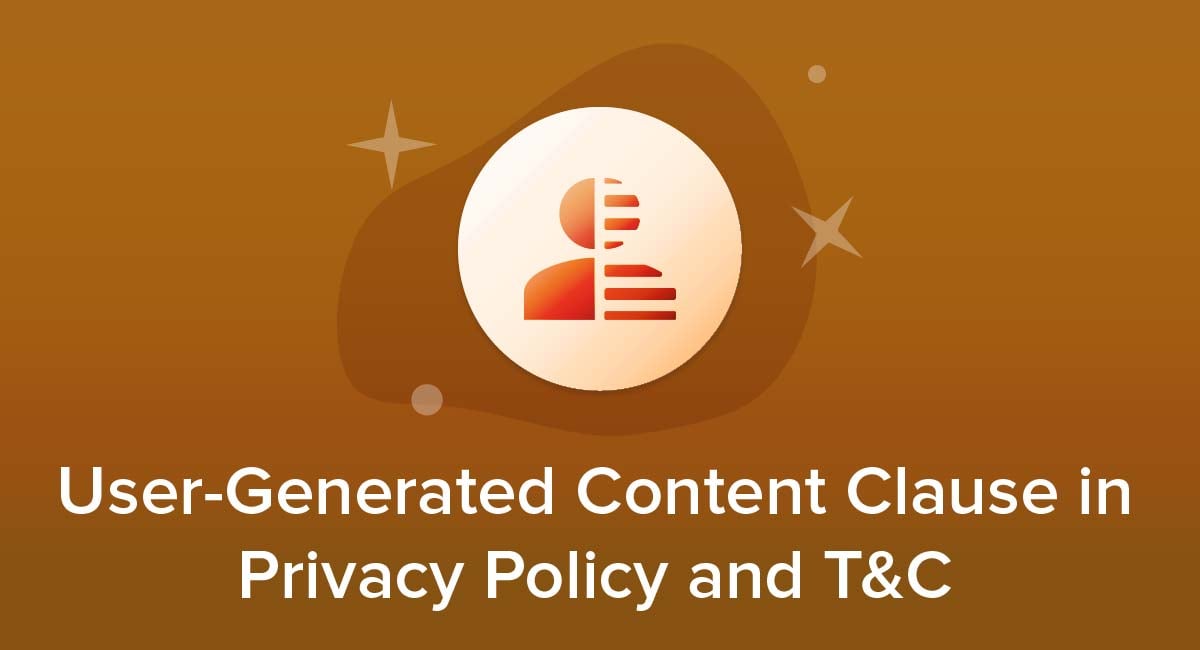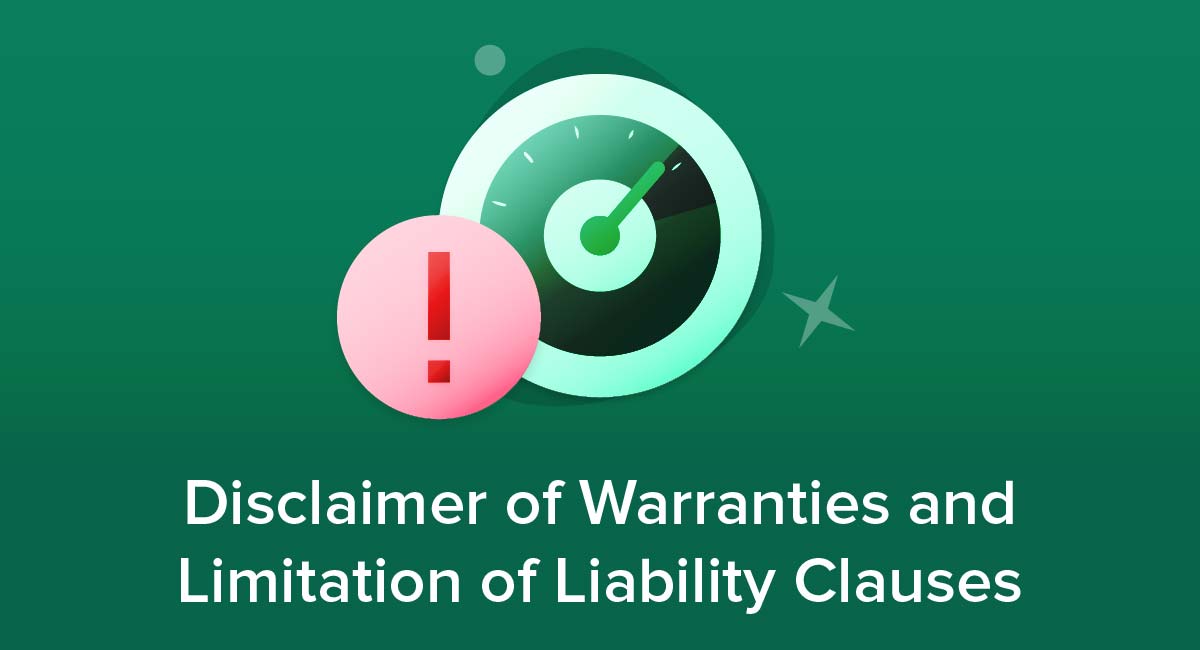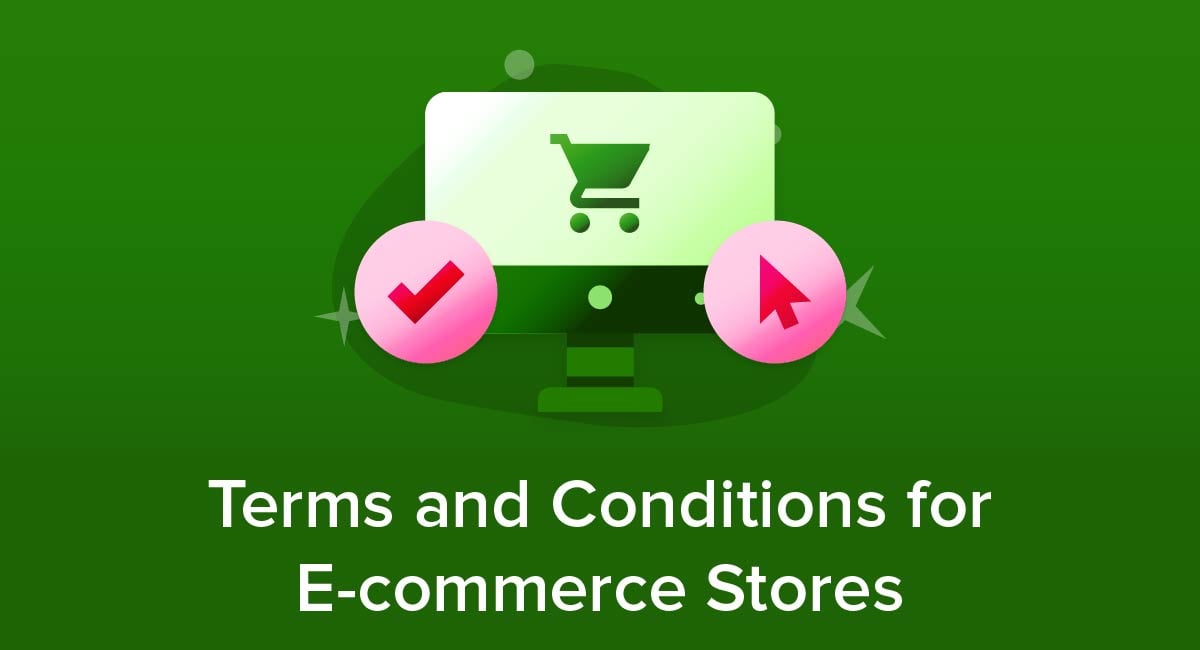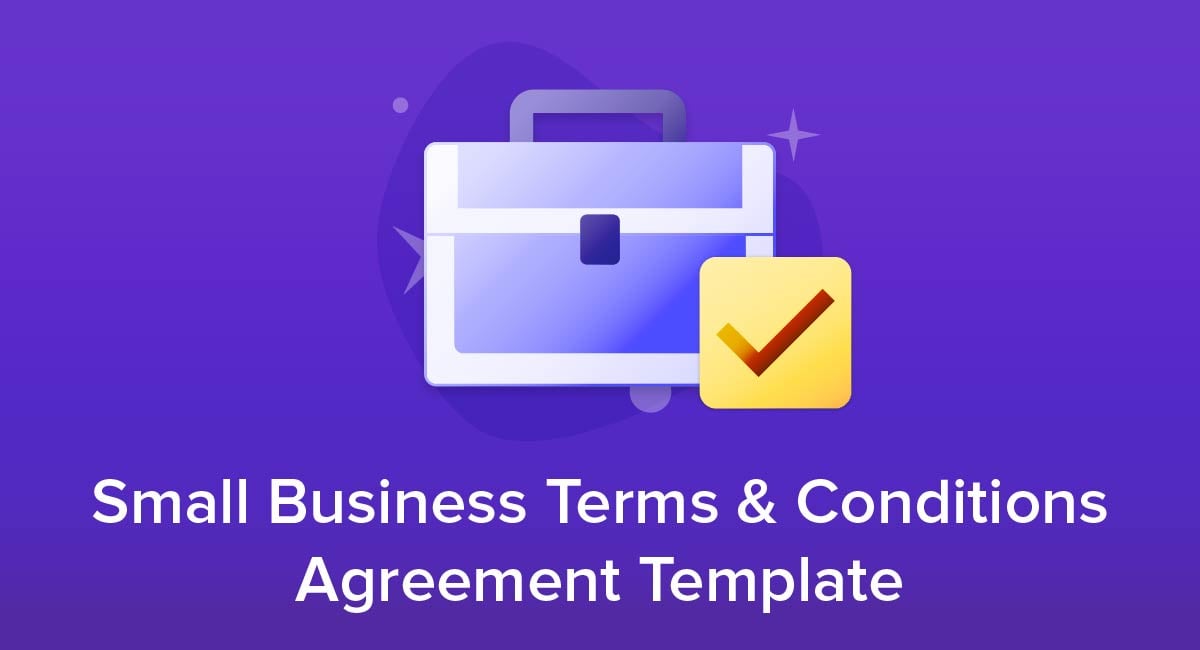
For a small business, having a Terms and Conditions agreement saves time and reduces legal disputes that can be cripplingly costly. While you may think your business is too small to need one, that just isn't the case.
This article will explain why your small business needs a Terms and Conditions agreement and what information you should put in yours. We'll also give insight into where to display your agreement once it's complete.
Our Free Terms and Conditions Generator is created to help you generate a professionally drafted agreement that can include various terms and conditions for your site and/or app.
- Start the Free Terms and Conditions Generator from our website.
- Select platforms where your Terms and Conditions will be used (website, app or both):
- Answer a few questions about your website or app information:
- Select the country:
- Answer a few questions about your business practices:
-
Enter your email address where you'd like to receive the new Free Terms and Conditions and click "Generate":
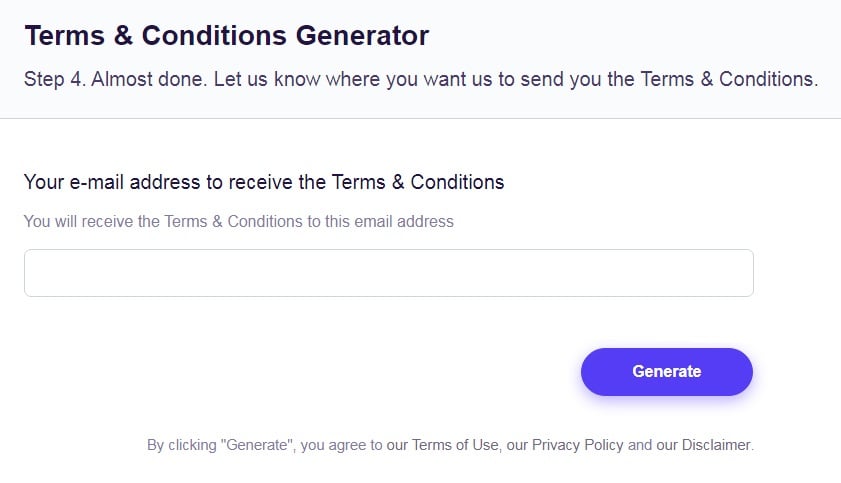
Once generated, you can copy and paste your Free Terms and Conditions agreement on your website or app or link to your hosted Free Terms and Conditions page.
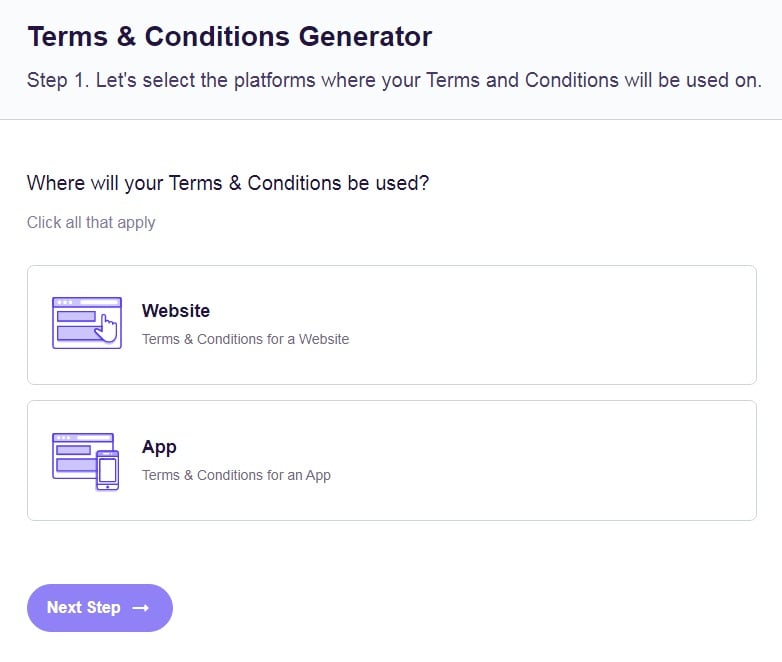
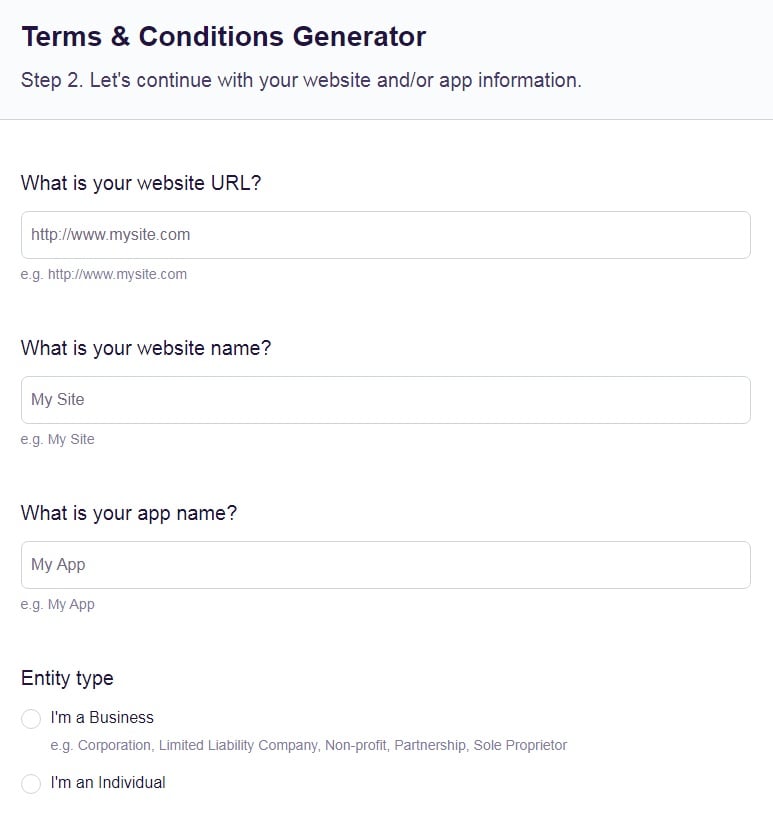
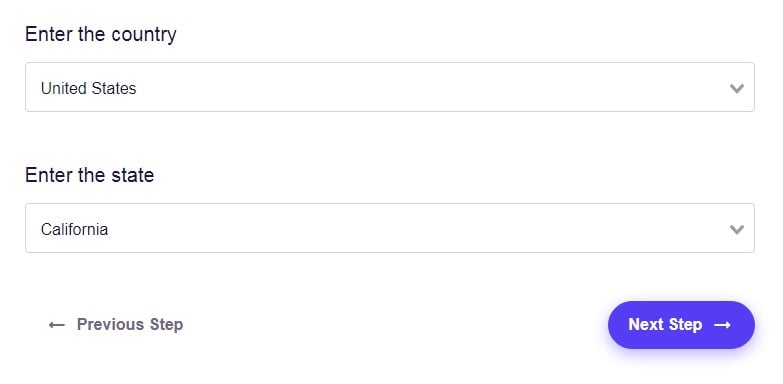
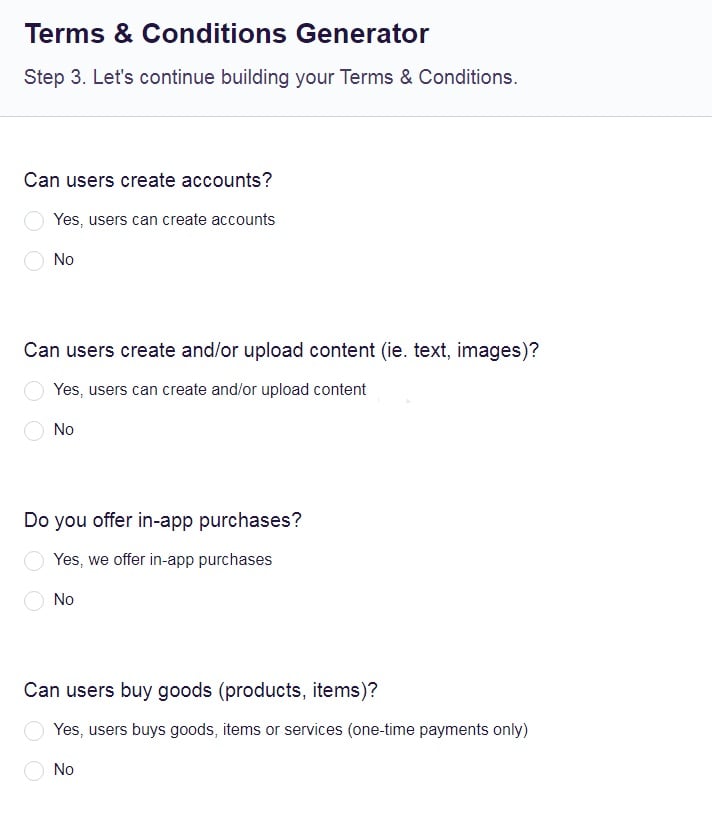
- 1. The Terminology Behind a Terms and Conditions Agreement
- 2. Why Have a Terms and Conditions Agreement?
- 3. Can I Put Anything in a Terms and Conditions Agreement?
- 4. What Clauses to Include in a Terms and Conditions Agreement
- 4.1. Pricing
- 4.1.1. Taxes
- 4.1.2. Delivery
- 4.1.3. Accepted Currencies
- 4.1.4. Price Increases
- 4.2. Availability of Your Services
- 4.3. Payment Terms
- 4.4. Returns and Refunds
- 4.5. Liability and Warranty
- 4.6. Governing Law
- 4.7. Intellectual Property
- 4.8. Termination of the Agreement
- 4.9. Data Security and Your Privacy Policy
- 4.10. Assignment
- 5. Displaying Your Terms and Conditions Agreement
- 6. Getting Consent for Your Terms and Conditions Agreement
- 7. Summary
The Terminology Behind a Terms and Conditions Agreement
In this guide we've used the phrase "Terms and Conditions agreement" as this is the most common and widely-understood name for this particular collection of information.
Sometimes you'll see businesses use other terms such as:
- Terms of Use
- Terms of Business
- Standard Terms
These usually mean the same thing, but it's best to use the same phrase consistently.
Remember that a Terms and Conditions agreement is not the same thing as a contract. In fact, they help keep contracts simpler. That's because your Terms and Conditions cover general points that apply to all your sales and customers, so you don't have to repeat them in full in every contract.
Why Have a Terms and Conditions Agreement?

While having a Terms and Conditions agreement isn't a legal requirement, having one brings a host of benefits including:
- Giving you the ability to set the various terms and conditions that your business operates under, and that your customers must adhere to
- Avoiding legal disputes
- Making cash flow and inventory management easier because you have greater certainty over payment dates, delivery times and return windows
- Making it easier to have straightforward online sales as customers can simply confirm agreement to the Terms and Conditions rather than you having to send them a full written contract
Can I Put Anything in a Terms and Conditions Agreement?
In principle, you can set any terms and conditions you like and then leave it to customers to either adhere to them or not buy from you.
In practice, many jurisdictions have rules that limit or ban particular terms in a Terms and Conditions agreement that may be unfair or contrary to laws. In some cases, these terms are unenforceable even if the customer has agreed to them.
To address this issue, many Terms and Conditions agreements will include a severability clause that states that even if one part of the agreement is found to be invalid by a court, the rest of the terms remain in force.
Here's how Zendesk uses a severability clause:

Make sure you understand and follow laws in your jurisdiction when creating the terms of your agreement to make sure they're legal.
What Clauses to Include in a Terms and Conditions Agreement

Exactly what to include in your Terms and Conditions agreement may vary depending on the nature of your business and customers. We've included a wide range of content in this article, most of which should be relevant to most businesses.
Pricing
A Terms and Conditions agreement should cover general points that apply to pricing for all sales, such as taxes, delivery rates, what currencies and payment methods are accepted, and a notice that prices may increase at times.
Taxes
Include a clause that details the following:
- What taxes (eg sales taxes) apply
- How you calculate them (if there's any potential for confusion)
- Whether you include taxes in listed prices
- Whether customers will need to reclaim any taxes
CWT sets out how it handles taxes on purchases:
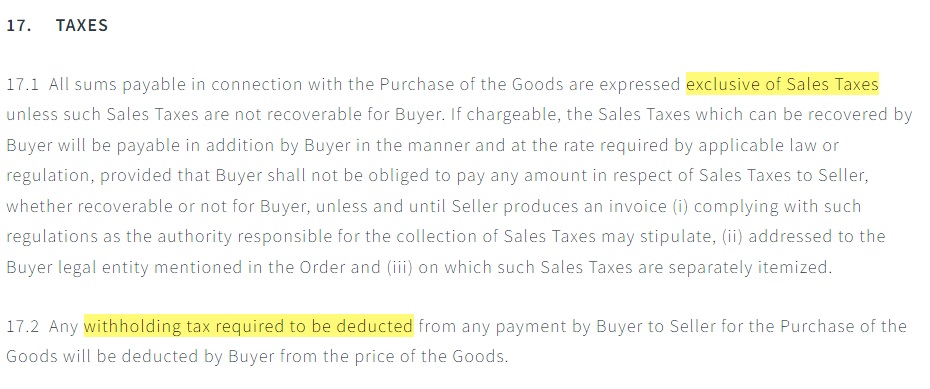
Delivery
Outline your policy on delivery costs, for example whether you have a flat-fee, charge by weight, or charge based on value, and whether location makes a difference. Explain when you add delivery costs (eg include them in listed prices or add them at the point of sale).
Glass-Safe explains how it calculates delivery costs and when they might change:
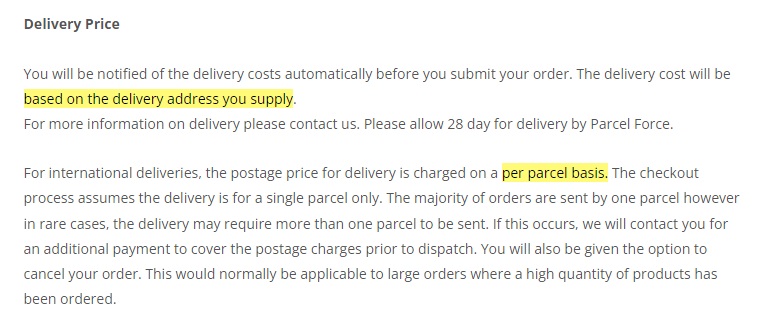
Accepted Currencies
If you are selling to customers in other countries, set out what currency you use for pricing. If you offer payment in multiple currencies, set out what happens if the exchange rate changes, for example between a customer placing an order and you delivering goods.
MR PORTER sets out how currency rates come into play:

Price Increases
It's common to include a clause or statement that lets customers know that your prices may increase at times, and that you reserve that right.
Disclose how you will inform customers of a price rise, if you plan to do so. You can also note whether the customer has the right to cancel an ongoing agreement (such as a subscription) when you raise prices.
Razzo Studio explains how prices could increase and whether customers can cancel the contract:

Availability of Your Services
If you sell ongoing services such as a subscription product, set out any guarantees (or lack of guarantees) that you make about their availability.
This could include:
- Whether you guarantee the service will be available a certain proportion of the time
- Whether you offer any compensation or alternatives if a service isn't available
- What happens if factors beyond your control stop you providing the service (and what those factors are)
Shopify makes clear it offers no guarantees on availability:
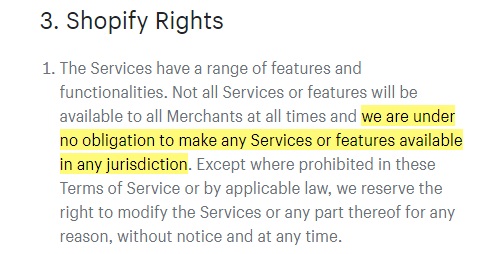
Contrastingly, Splunk guarantees a level of availability and compensation if it falls short:
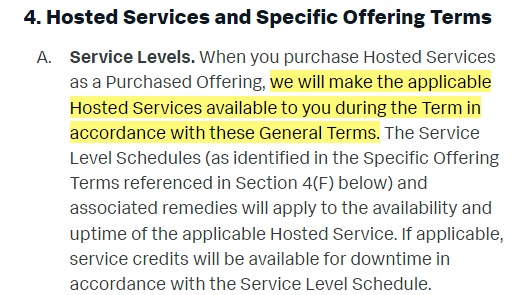
Payment Terms
A payment terms clause should set out any rules or arrangements about how and when customers pay you. Getting this clear is particularly important for small businesses as it reduces the risk of late payment that could hurt your cash flow.
Points to cover include:
- When payment is due
- What forms of payment you accept
- Whether you require a single payment or installments
- What happens if somebody doesn't pay on time, eg withdrawal or suspension of service
- Whether you charge interest for late payments and, if so, what interest rate applies
- Whether you offer discounts for early payment
It can be useful to list contact details for your accounts or finance departments to speed up any queries about payments.
Jane Means sets out when it collects payment and what happens when collection isn't possible:

Returns and Refunds
Clearly explain what returns you allow and how your return process works. Include information on the following points:
- The circumstances when customers can return goods (and when they cannot)
- What time limits apply
- Who pays for and arranges the return
- Whether customers can return goods to the store they bought them, to any store, or by mail only
- Whether the goods must be in a particular condition, whether they need the original packaging and whether the buyer must include any tags or documentation
- How to initiate or request a return
- Whether the refund will cover the original shipping costs for mail order and online orders
Your specific policies may vary depending on whether the customer is exercising a legal right to return something (for example, if it's faulty) or if they are simply taking advantage of your policy. Make clear which rules apply in which case.
Smith & Nephew uses a concise returns clause:

Meanwhile The Dib Studio goes into much more detail:
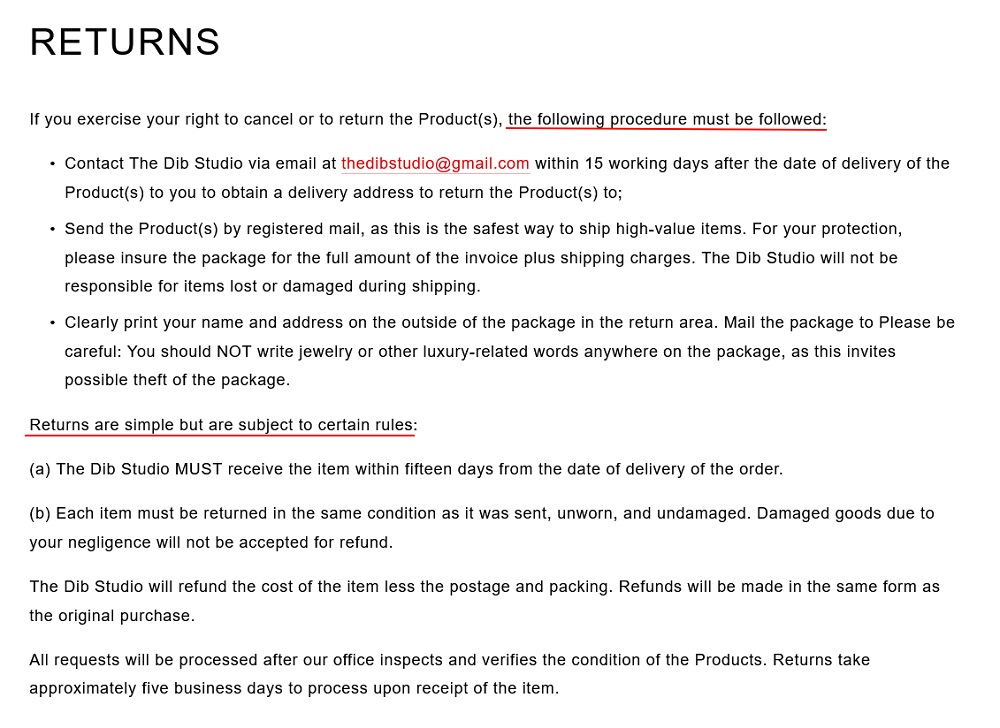
Liability and Warranty
These are two separate but connected legal points. Sellers will often address them and try to reduce the chances of a customer taking legal action against them, or the chances that such action is successful.
Liability means legal responsibility for any harm caused by a product or service. This could be physical damage or injury, or financial loss. A "limitation of liability" clause means clearly setting out that you only accept liability where the law says you must.
Twilio uses the interesting approach of a legal liability term besides a "plain language" summary:
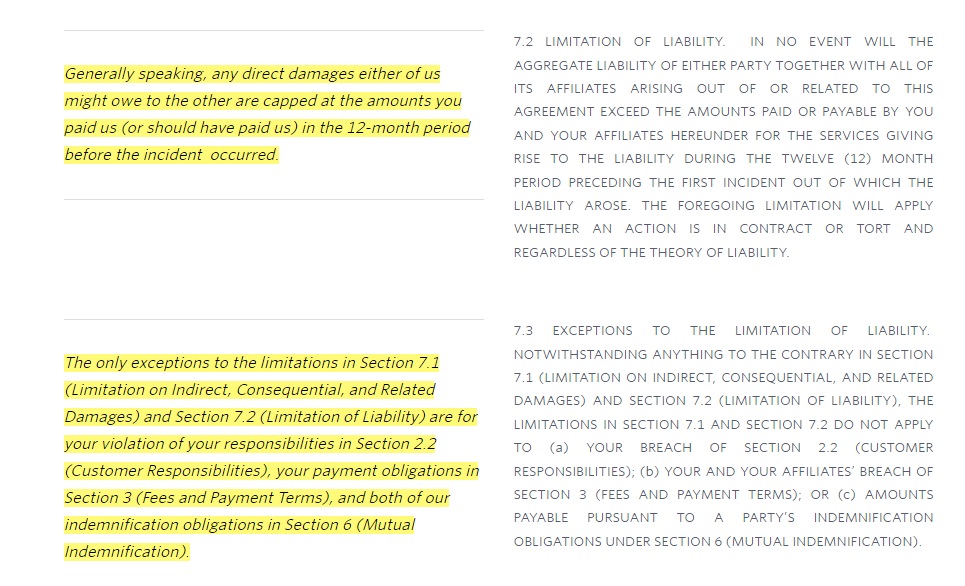
A warranty is a legal promise. For sellers this usually means a promise that goods or services are as described and suitable for the advertised purpose, without significant faults. Buyers may rely on an implied warranty, meaning they can reasonably infer that you were making such promises even if you don't specifically say so.
A warranty disclaimer makes clear that you are offering no warranties beyond those which the law requires.
Santander Private Banking makes clear it disclaims all warranties and then gives examples of some promises that it is intentionally not making:
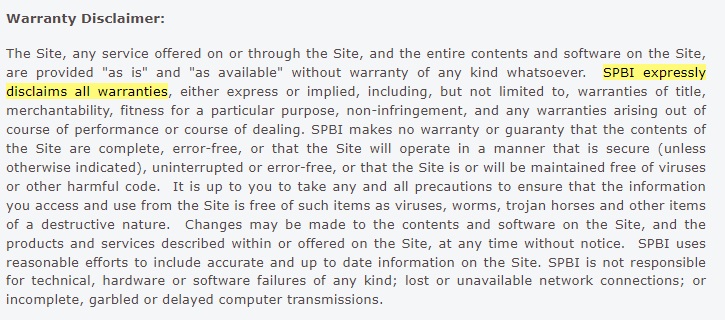
Governing Law
This clause sets out rules for how any legal disagreement between the seller and buyer plays out. Key points include:
- Which jurisdiction's laws cover the contract between seller and buyer
- Where the buyer must bring any legal action
- Whether the two sides must go through arbitration either before or instead of going to court
Claris sets out which jurisdiction applies and the process for settling a dispute before any court action:
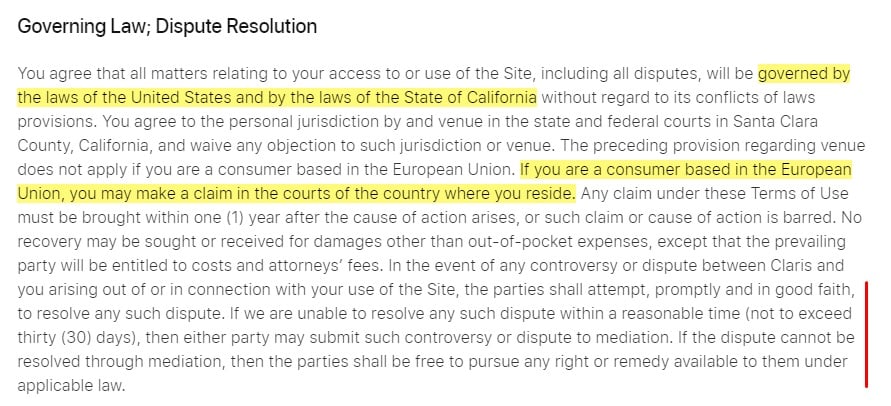
Intellectual Property
You may need to establish that you hold intellectual property such as copyright, patents or trademarks. You should also set out the conditions under which you let a buyer use your intellectual property and make clear you are not giving any permission beyond this.
If you provide services or tools that help customers create something, you may want to clarify who owns the intellectual property in whatever they create. Remember that establishing the customer owns the intellectual property might make them more likely to buy your product or service.
POLITICO sets out the intellectual property relationship with its customers in both directions:
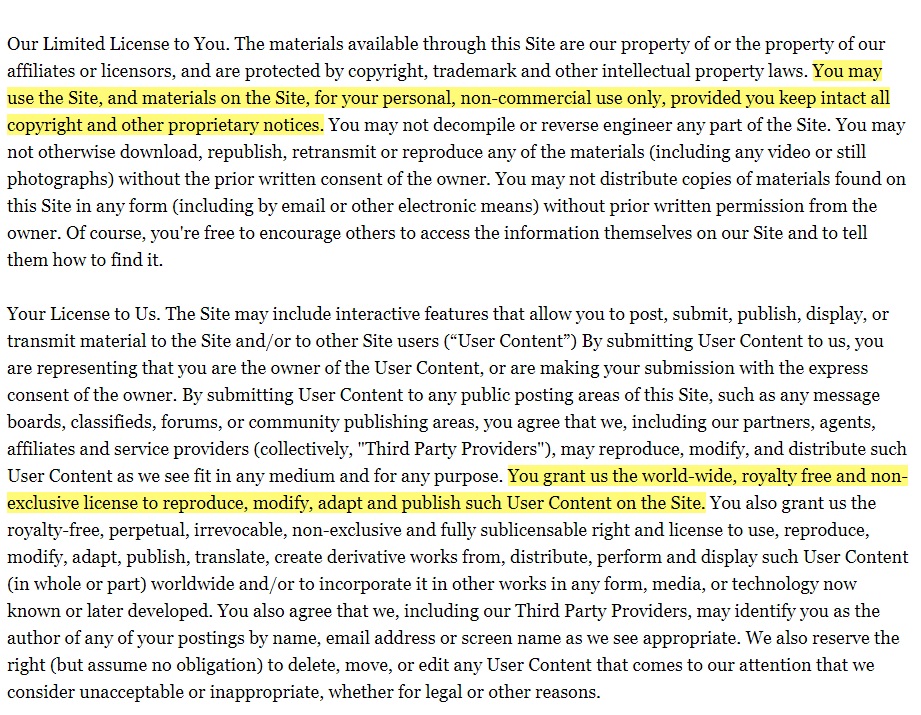
Termination of the Agreement
Your Terms and Conditions agreement needs to explain:
- Any fixed or minimum term that the contract runs
- Whether the service automatically renews or continues at the end of this term
- When and how the customer (or you) can cancel the contract
- How much notice is necessary to cancel the contract
- Whether the customer gets a prorated refund after ending a contract early
Hootsuite sets out both the legal rights of either side to end the agreement and the effects of termination:
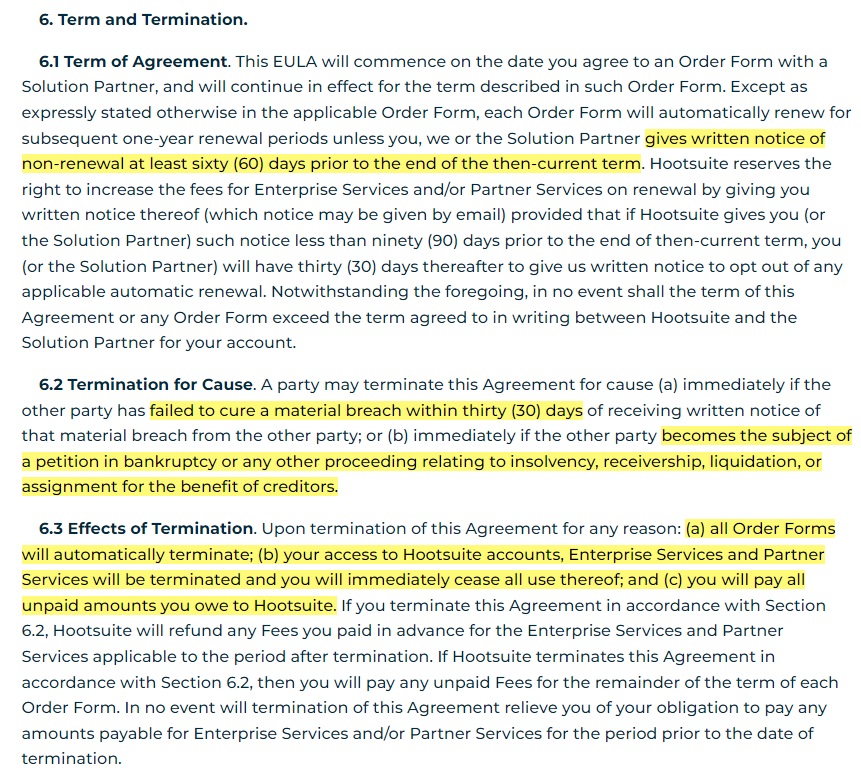
Data Security and Your Privacy Policy
Let users know that you take steps to secure their data. If you have a Privacy Policy (which you legally need to have), consider linking it to a relevant clause in your Terms and Conditions agreement. Cross-linking legal agreements is an effective way to connect the dots between your rules, requirements, and user rights.
Here's how Atlassian summarizes its security processes while linking to its full Privacy Policy where users can find out more specifics:
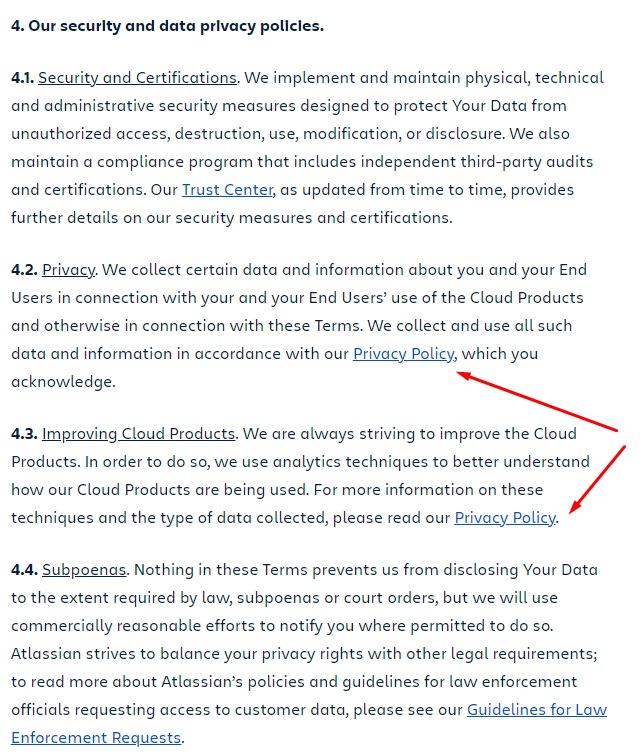
In its introduction clause, Mailchimp notes its Privacy Policy along with other policies and agreements:

Assignment
An assignment clause gives you the power to transfer your rights in a contract to another party. This could happen if you cease trading, sell your business, are taken over, or are part of a merger. This is most likely to be relevant for ongoing services and subscriptions.
The assignment clause could also cover your right to sub-contract services or delivery to another business, as well as responsibilities and rights. For example, you could say that if you sell your business, the new owner will take on the responsibility for dealing with returns from previous sales.
Spotify has a short and simple assignment clause:

As a small business, you might find it harder to persuade customers to accept such a one-sided clause, but it's still important to acknowledge this topic.
Displaying Your Terms and Conditions Agreement

The most important thing to keep in mind when deciding where and how to display your Terms and Conditions agreement is that it needs to be easily noticeable and always accessible. The most standard place to display a link to your Terms agreement's dedicated webpage is in your website's footer.
Return2Play includes a clear link to its Terms and Conditions agreement at the bottom of every page:

You can link to the Terms and Conditions agreement when a customer is about to make a purchase (and thus form a contract with you). As well as a standard link, you could set the link to open the agreement in a new page or open it in a pop-up window. If the agreement is relatively short, you could show it on the order page itself or have it in a drop-down window that only appears when the customer clicks a button.
Etsy's website is designed so that users see link to the Terms and Conditions agreement when they are about to sign in, which is another great way to display a link to your agreement:
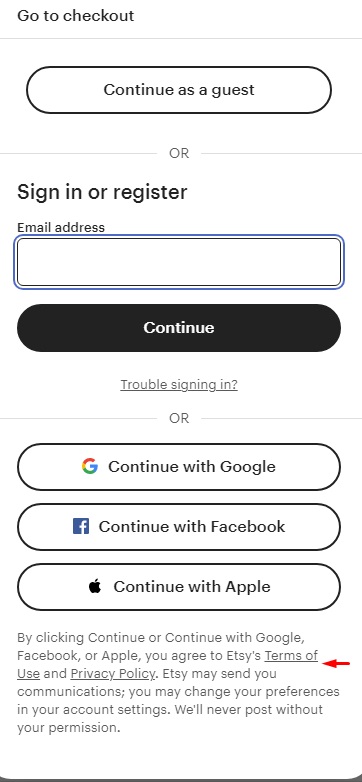
Just make sure you display your agreement in places where a user knows to look, and where it's always accessible and easy to notice. You never want to hide your agreement or make it very difficult to track down.
Getting Consent for Your Terms and Conditions Agreement

Getting confirmation that the customer has read and agreed to the Terms and Conditions agreement will, at the very least, strengthen your case in any legal dispute.
You can use a range of methods to get this confirmation such as:
- Noting on the page that proceeding with the order counts as confirmation
- Including a button to click as confirmation
- Including a checkbox or toggle to show confirmation and then not allowing the customer to proceed until they have selected the relevant option, eg "I Agree"
Which to use may depend on how important it is that you can prove the customer's agreement. Option 1 is the bare minimum and option 2 may be more suitable if you want to avoid any risk that the customer later claims they didn't know about something in the terms and conditions agreement.
Spotify uses a mix of options 1 and 2:
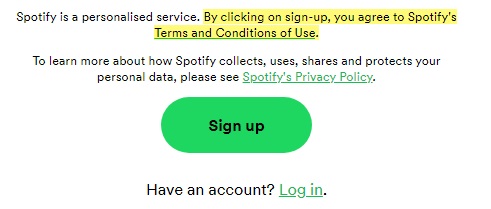
Option 3 is best to get the most clear, certain consent from users that they agree to be bound by your terms.
British Gift Box uses an unchecked tickbox, meaning customers can't complete an order without intentionally ticking to confirm the accept the Terms and Conditions agreement:
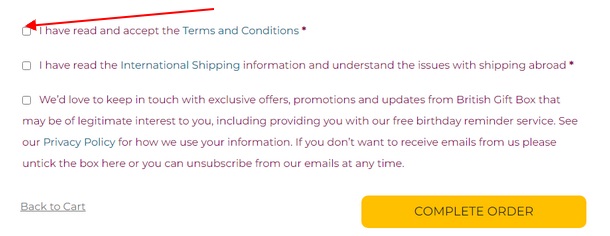
The Shop Box not only does this, but highlights the importance of the checkbox in the Terms and Conditions agreement itself:

Summary
Let's recap what you need to know about a small business Terms and Conditions agreement.
A Terms and Conditions agreement sets out the key rules that apply to all of your sales. It forms part of your contract alongside the details of a specific sale such as product, price and customer details.
Having a Terms and Conditions agreement brings certainty, builds trust, and reduces the chances of legal disputes.
While the Terms and Conditions agreement doesn't cover the actual price, it should address related policies such as:
- Taxes
- Delivery costs
- Accepted currencies
- Price increases
Other points to address in the Terms and Conditions agreement include:
- Availability of your service
- Returns
- Liability limitation and warranty disclaimers
- Dispute resolution
- Intellectual property
- Term length and ending contracts
- Data privacy
- Assignment
The best way to display your Terms and Conditions agreement is as a dedicated web page that you link to when a customer is about to confirm a purchase.
Use a clearly-labeled button, checkbox or toggle for customers to confirm they have seen and accept your Terms and Conditions agreement.
